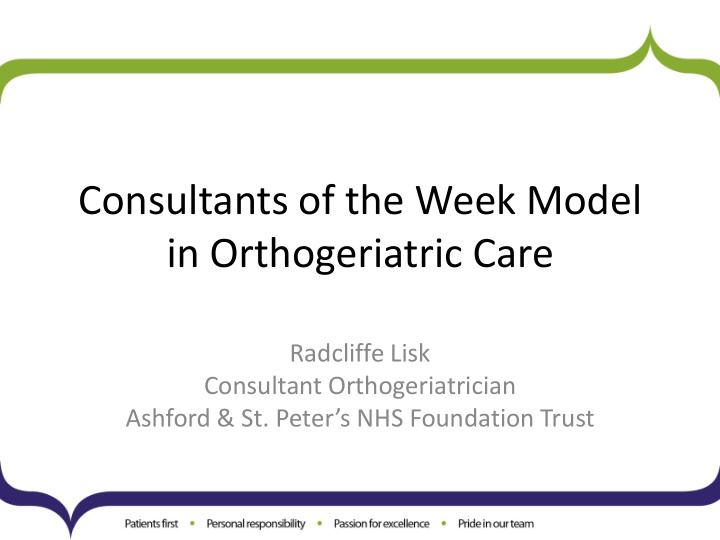



Consultants of the Week Model in Orthogeriatric Care Radcliffe Lisk Consultant Orthogeriatrician Ashford & St. Peter’s NHS Foundation Trust
Location St Peter’s Hospital Ashford Hospital
Average life expectancy • In the 20 th century, the average lifespan of a male in the UK has risen from 45-75 and females from 49-80. Mortality from hip fractures ASPH vs national
Ashford & St. Peter’s - Demography Percentage of hospital admissions from A&E by age group – NHS Benchmarking Report 2017 Group Your position Average position Age 0 to 64 46.51 51.15 Age 65 to 74 12.37 13.99 Age 75 to 84 20.02 17.61 Age 85 plus 21.10 15.12
• We can no longer afford to be caring for older people the same way we have been doing for many years
Orthogeriatric Team • 2 Orthogeratricians • 17 orthopaedic surgeons • 16 junior doctors • Trauma coordinator • Dedicated physios • OTs • 400 hip fractures annually
Orthogeriatric Models of Care • Traditional model • Newer models of orthogeriatric care – Routine orthogeriatrics review – Admitted under geriatricians • Shared care model – patients are managed throughout their stay by • named orthopaedic surgeon • named orthogeriatrician within a defined orthogeriatric team
Ward Rounds • Daily attendance at Trauma Meetings (0800-0830hrs) • Pre op review of # NOF fractures (0830-0900hrs) • Ward Rounds (0900-1115hrs) NOFs 1. Dr Yeong – Mondays and Fridays and alt. Weds 2. Dr Lisk – Tuesdays and Thursdays and alternate Wed Board Round all patients MDT (1130hrs – 1200hrs) DAILY
Drivers for change • The orthogeriatrician focused on the hip fracture patients (NoFs) whereas the orthopaedic surgeon focused on the other trauma patients. • Trauma patients frail with fragility fractures and medical needs not addressed • Orthopaedic needs of hip fractures were delayed • Poor GMC trainee report – only 68.3% satisfied in 2016
Innovative Model of Care • The Consultants of the Week Model (CoW) • X1 Trauma ward (30 beds) • The same orthopaedic surgeon and orthogeriatrician see patients on the ward round. (trainees designated to each half) – Mondays, Tuesdays – all patients; – Wednesdays, Thursdays – half the ward (trainees focus) – Fridays – all patients seen with handover to another orthopaedic surgeon who will be CoW next week
Results • Before the CoW model (July – Oct 2016), the LOS for NoFs was 13.13 days and after the CoW model (Nov – Feb 2017), the LOS was 13.33 days. • Trauma patients, before CoW (same period), LOS was 7.77 days and after CoW 6.49 days. • Readmissions NOFs: 16.0% before CoW and 13.1% after CoW. • LOS on readmission before CoW 13.05 days • LOS on readmission after CoW 7.81 days.
Results • Midnight bed occupancy: 26.77 before CoW and 24.44 after CoW. • We receive 1291 other traumas annually; approximate saving over £400K • 1.28 day reduction for other traumas • £275/bed • Further cost saving in NOFs as less readmissions and reduced LOS for readmissions • GMC trainee report – 80.46% satisfied in 2017 (best ever result)
Conclusion • Fragility fractures are a significant cost burden and as our population is increasingly ageing, so too will be the incidence of this injury. • This model of care addresses the needs of this older population with frailty and complex co-morbidities whereby continuity and working together achieves cost savings.
Recommend
More recommend